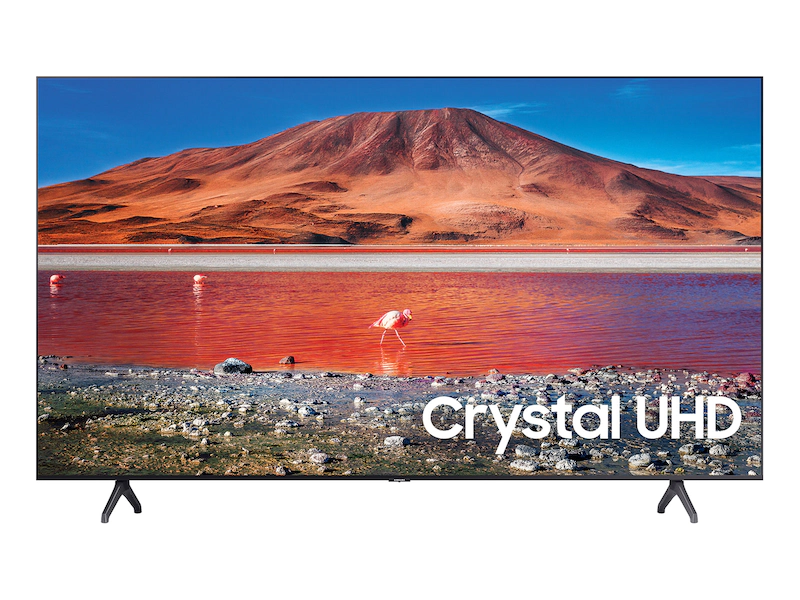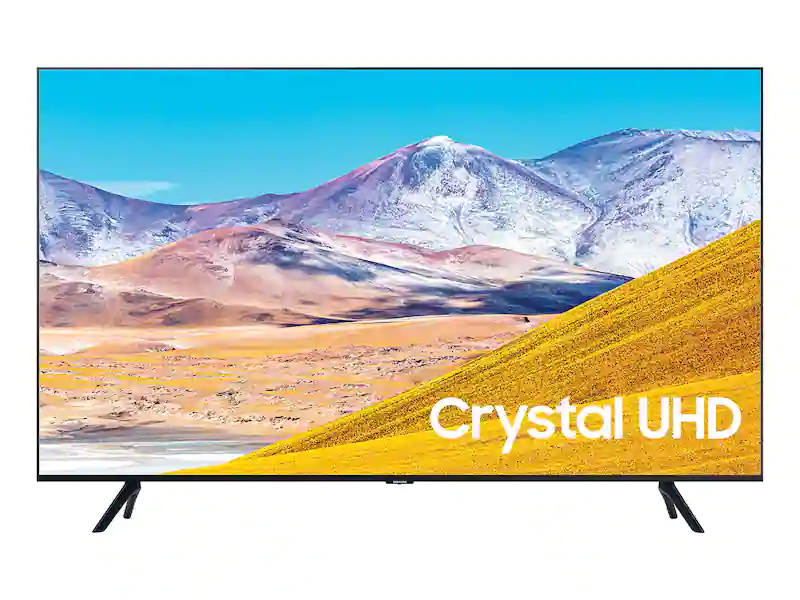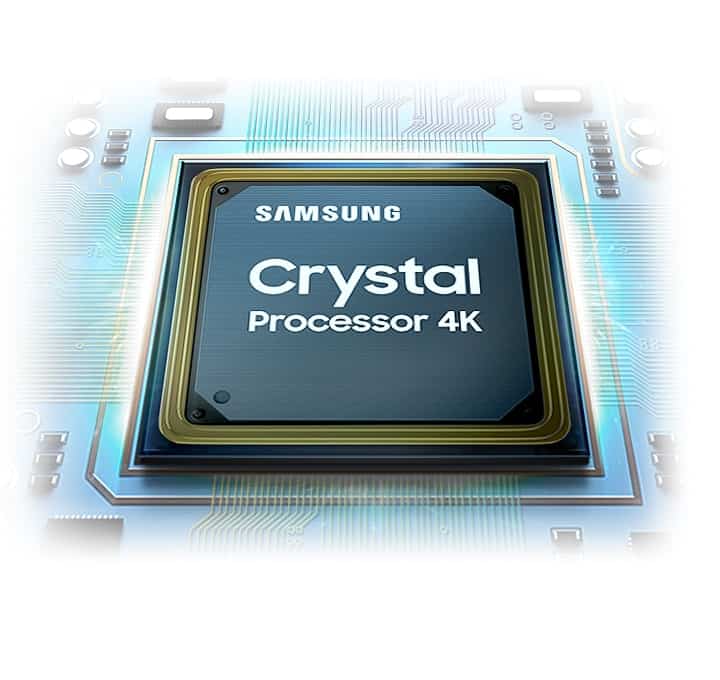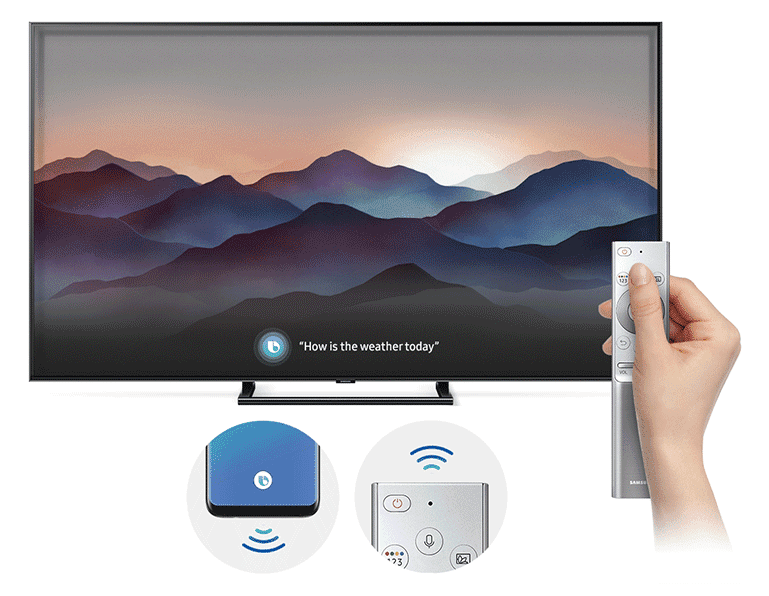Samsung is the leading manufacturer of high-end Smart TVs. That said, the company has also done an excellent job at creating an entry-level line of TVs for budget buyers. The two models we’ll highlight in this article are perfect examples of this. So, if you’re looking for a Samsung TV at a fair price, read this Samsung TU7000 vs TU8000 comparison post to see which model is the more attractive buy.
Samsung TU7000 vs TU8000 – Quick Comparison
Samsung TU7000

The TU7000 is a superb entry-level TV set for budget buyers. It’s still a Samsung TV and includes some first-class attributes, but it is a step down from its more expensive and better-performing models. Here’s a quick look at the TU7000’s biggest advantages and disadvantages:
Pros:
- HDR10+
- Great contrast ratio
- Affordable for a Samsung 4K TV
- Clean and stylish design
Cons:
- No local dimming
- No voice control support
Samsung TU8000

The TU8000 is an excellent option for buyers looking for a TV that delivers decent performance but doesn’t break the bank. This model produced detailed images and has strong upscaling abilities and motion handling properties. Here are TU8000’s most significant pros and cons:
Pros:
- HDR10+
- Excellent voice assistant
- Impressive contrast ratio
- Exceptional black uniformity
Cons:
- No local dimming
- No VRR, G-SYNC, or FreeSync
Features Face to Face
Panel Technology
The TU7000 and the TU8000 use the same panel technology, Samsung’s Crystal UHD panels. Although this technology sounds advanced and sophisticated, it’s actually a step down from the company’s branded QLED technology that you can find in their more expensive models, starting with medium-range sets like the Q6DT and the Q60T.
The TU7000 and the TU8000 also only support a 60Hz refresh rate, which is a bit disappointing considering that most newer Samsung TVs have a 120Hz refresh rate.
Image Processor

Besides outfitting these two models with the same panel type, Samsung installed the same image processor, the Crystal Processor 4K. While it’s not nearly as capable as the AI-powered processor that comes with more expensive Samsung models, the Crystal Processor 4K delivers a solid performance. It has powerful 4K upscaling capabilities, Object Tracking Sound Lite, and a Dynamic Crystal Color feature.
Motion Technology
The TU8000 delivers better response times than the TU7000. Comparing the numbers, the TU8000 fully transitions between colors in just under 18 milliseconds, while the TU7000 does so in around 18.5 milliseconds.
That said, this difference is more substantial because the TU8000 flickers at 240Hz, while the TU7000 flickers at only 120Hz. In short, this causes the TU7000 to display more motion blur in fast-moving content and show more overshoot in darker transitions.
Picture Quality
For most buyers, the most important aspect of picture quality for most buyers is the diversity of supported resolutions. And, in this context, the Samsung TU7000 and the Samsung TU8000 come with identical picture quality properties. With that in mind, let’s go over all of these two models’ supported resolutions:
| Resolution | Samsung TU7000 | Samsung TU8000 |
|---|---|---|
| 4K/120Hz | No | No |
| 4K/60Hz/4:4:4 | Yes | Yes |
| 4K/60Hz | Yes | Yes |
| 1440p/120Hz | No | No |
| 1440p/60Hz | Yes (Native Support) | Yes (Force Resolution) |
| 1080p/120Hz | No | No |
| 1080p/60Hz/4:4:4 | Yes | Yes |
Contrast Ratio / Black Level
Samsung TU7000 has an excellent contrast ratio of around 5,110:1. In simple terms, such a high contrast enables this TV to display black tones that always look deep and rich. That said, the TU8000 outperforms the TU7000 in this category, as it delivers an exceptional native contrast ratio of 6,420:1. Keep in mind that the contrast might slightly vary between units.
Local Dimming
The TU7000 and the TU8000 both use an edge-lit backlight configuration. This is a less preferred configuration, as TVs with a full-array backlight generally deliver better overall screen uniformity.
Moreover, neither TV has a local dimming feature, so comparing the Samsung TU7000 vs TU8000 in this context doesn’t produce any results. It also means that you can’t improve the existing native contrast ratio.
Peak Brightness
The TU7000 and the TU8000 deliver subpar SDR peak brightness numbers. Moreover, they have even lower HDR peak brightness numbers. They can’t get bright enough to combat glare and can’t produce very bright images, even on a smaller scale. Here’s how the two models compare in terms of their peak brightness values:
| Brightness Values | Samsung TU7000 | Samsung TU8000 |
|---|---|---|
| Peak 10% Window SDR Brightness | ∼ 250 nits | ∼ 300 nits |
| Peak 100% Window SDR Brightness | ∼ 250 nits | ∼ 300 nits |
| Peak 10% Window HDR Brightness | ∼ 270 nits | ∼ 290 nits |
| Peak 100% Window HDR Brightness | ∼ 265 nits | ∼290 nits |
As you can see from the table above, the TU8000 is a slightly better performer across all peak brightness parameters. Additionally, while both models deliver relatively poor peak brightness values, they maintain consistent numbers even when covering the screen’s entire surface. In other words, while vivid colors most often won’t be displayed in their full radiance, you won’t notice any loss of fine details in the 100% window compared to the 10% window.
Color
After comparing Samsung TU7000 vs TU8000 through their color volumes, we’ve found that the two models offer equally mediocre color volumes. These two TVs have an excellent contrast ratio, and they display darker colors very well. However, they can’t reproduce bright colors, especially when it comes to brighter blue tones.
Additionally, these two TVs have equally basic color gamuts. They have solid coverage of the DCI P3 color space but can’t display a wide color gamut necessity for delivering true HDR content. Likewise, the TU7000 and the TU8000 have inadequate Rec. 2020 coverage. This puts them at a disadvantage compared to most modern TVs and offers very little future-proof value.
Viewing Angle
The TU7000 and the TU8000 have equally poor viewing angles. This comes as no surprise, as most VA LED panels offer disappointing viewing angles and quickly lose accuracy when viewed from the side. In this specific case, the two TVs start losing their brightness at viewing angles of around 35 degrees and above. Moreover, they display gamma shifts at angles twice as low.
With that in mind, if wide viewing angles are one of the more important criteria for you when choosing a new TV, consider an LG OLED TV, like the LG C8 or the LG C9. These two TVs and most LG OLED models, in general, offer substantially better viewing angles than Samsung TVs.
Reflections / Anti-glare
The two TVs both have a semi-gloss screen finish, which is the less desirable coating, as it reflects more light than the preferred glossy finish most newer Samsung models come with. With this in mind, the TU7000 and the TU8000 are good options for moderately lit viewing environments but struggle to perform in well-lit rooms, especially when placed opposite a bright light source.
To put this Samsung TU7000 vs TU8000 reflection handling comparison into numbers, the TU7000 reflects just over six percent of total light that hits its surface. By comparison, the TU8000 reflects around five and a half percent, making it a slightly better performer in this category, but not enough to have a clear edge.
Sound Quality
The TU7000 and the TU8000 record very similar frequency response numbers. They deliver a well-balanced sound profile with a relatively light bass. Neither TV can get very loud, so you shouldn’t expect them to perform well in large and noisy environments. Moreover, when you push them to their maximum volume levels, the TU7000 and the TU8000 will produce some compression artifacts.
Equally as important, the two TVs sound clean and don’t generate any distortion at moderate volume levels. Surprisingly, the TU8000 does display more distortion and performs worse than the TU7000 in this regard. That said, your experience will depend on the content and the volume, so you might not notice it.
Smart TV Platform (Operating System)
Like all newer Samsung TVs, the TU7000 and the TU8000 run on the company’s in-house Tizen Smart TV platform. In this case, the two models we’re comparing in this article use a simplified version of this OS. In other words, they have some reduced features and don’t come with as many menu animations as TVs that employ the full Tizen OS version. Here’s a more detailed table covering the two TVs’ OS capabilities:
| OS Features | Samsung TU7000 | Samsung TU8000 |
|---|---|---|
| OS Version | Tizen OS (2020 Version With Reduced Features) | Tizen OS (2020 Version With Reduced Features) |
| Time to Change Backlight | 7 seconds | 7 seconds |
| Time to Load YouTube | 2 seconds | 2 seconds |
| HDR Netflix/Youtube | Yes | Yes |
| App Selection/Variety | 9/10 | 9/10 |
| App Smoothness | 7/10 | 7/10 |
| Ease of Use | 8/10 | 8/10 |
Connectivity
Users who want to take full advantage of their TV’s performance capabilities also pay great attention to its connectivity properties. To ensure we cover every essential detail in this Samsung TU7000 vs TU8000 piece, we’ll also compare them through several connectivity characteristics. These include input specifications, voice assistants, and wireless technologies.
Inputs
In a Samsung TU7000 vs TU8000 input comparison, the latter model has an edge, as it comes with more USB and HDMI inputs. For a more thorough rundown of these two models’ input specifications, check out the table below:
| Input Ports | Samsung TU7000 | Samsung TU8000 |
|---|---|---|
| HDMI Ports | 2 HDMI 2.0 Ports | 3 HDMI 2.0 Ports |
| USB Ports | 1 USB 2.0 Ports | 2 USB 2.0 Ports |
| Digital Optical Audio Out | 1 Port | 1 Port |
| Ethernet Port | Yes | Yes |
Additionally, both models have impressive input lag times. With the “Game Mode” feature enabled, you can count on remarkably low input lag across all supported resolutions. Looking into the specifics, the two TVs have response times of around ten milliseconds. This is noticeably better than the 25-millisecond standard separating TVs with good response times from average input lag.
Voice Assistants

Unfortunately, the TU7000 doesn’t support any voice control features. While it is compatible with the Samsung SmartThings remote app, its remote doesn’t have a built-in microphone. In contrast, the TU8000 comes with the recognizable and minimalistic Samsung remote that comes with most modern Samsung TV sets.
This remote includes a built-in microphone you can use to ask for the most common control demands. You can set up and use Samsung’s Bixby voice assistant, Google Assistant, or Amazon Alexa. Some of the most convenient ones include changing the screen brightness, switching the input, or searching apps.
That said, you can’t use it to search for content within the apps themselves. Still, as the TU7000 doesn’t include any voice control options, the TU8000 has a clear edge in this category.
Wireless Technologies
Although we’ve discovered many differences between the two models in this Samsung TU7000 vs TU8000 comparison article, the two TVs are identical in their supported wireless technologies.
More precisely, both sets support Wi-Fi and Bluetooth. The latter technology is particularly convenient to have, as it enables you to connect additional speakers, a soundbar, headphones, or any other device you want to pair up with your TV set.
Standout Features
Despite the TU8000 being the slightly better model, it doesn’t have any standout features that set it apart from the TU7000. That said, the two TVs have one feature that differentiates them from non-Samsung TVs. Both models come with HDR10+, an enhanced version of HDR10 that adds dynamic metadata, much like Dolby Vision.
On the flip side, the two models lack many features, especially those essential for gamers. They have a fixed native refresh rate, as neither TV possesses a VRR feature. Moreover, neither the TU7000 nor the TU8000 is compatible with FreeSync or G-SYNC.
Conclusion
To sum up this Samsung TU7000 vs TU8000 post, we’d say that the latter model is undoubtedly a stronger performer and a better choice overall. The TU7000 doesn’t outperform the TU8000 in any notable category apart from gradient handling. Its main advantage is the more affordable price tag it comes with.
On the other hand, the TU8000 is better or equally as good as the TU7000 in every other category. It has faster response times, a higher contrast ratio and delivers better peak brightness values. Lastly, it also supports voice control features.